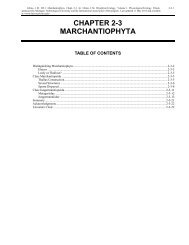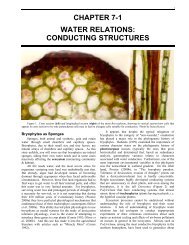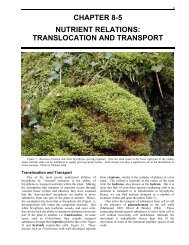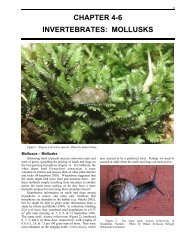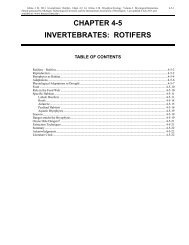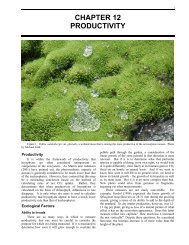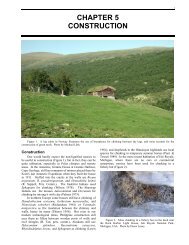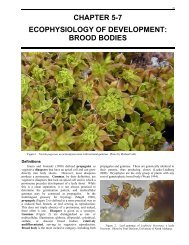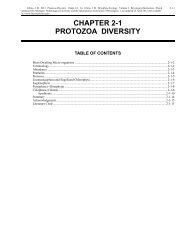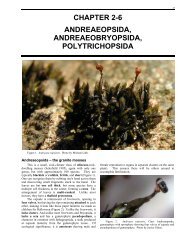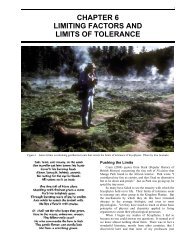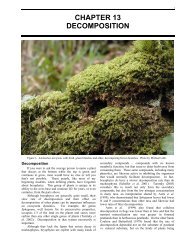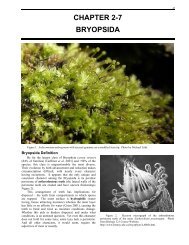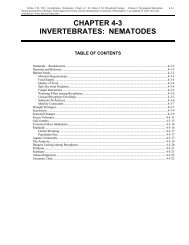120 Chapter 5-9: Ecophysiology <strong>of</strong> Development: SporophyteAt least in some taxa, the initiation for senescenceresults from the production <strong>of</strong> male gametangia or capsules.In many acrocarpous mosses, these structures caneffectively prevent further growth <strong>of</strong> the plant byoccupying what would have been the region <strong>of</strong> apicalgrowth, as shown for Tetraphis pellucida (Kimmerer 1991;Figure 35). In this species, high density increases sexualreproduction, which increases capsule production andproportion <strong>of</strong> males, which in turn initiate senescence forthe population. Some mosses overcome this apical growthtermination by producing innovations – side branches nearthe tip that become new tips and continue the growthupward (see <strong>chapter</strong> on gametophore <strong>development</strong>).Figure 35. Mature capsules that mark the onset <strong>of</strong>senescence in Tetraphis pellucida. Photo by Janice Glime.As in higher plants, it appears that ethylene inducessenescence, as shown in Marchantia (Stanislaus &Maravalo 1994). Spermine, spermidine, and putrescine canreverse it. If we dare to generalize from this meagerexample, the story makes sense. As the moss grows andthe cushion or mat (or whatever) becomes more dense,there is less and less air movement in the lower part <strong>of</strong> thegrowth form (see Figure 36). This permits gases toaccumulate, so if ethylene is being produced, this surely isa place for it to reach higher concentrations. Now all weneed to do is show that indeed there is ethylene given <strong>of</strong>fhere, that it accumulates, that it reaches high enoughconcentration, and that it indeed induces senescence inmost (all?) bryophytes!Figure 36. Senescence in lower, brown portion <strong>of</strong> Dicranumscoparium. Photo by Janice Glime.SummaryThe <strong>sporophyte</strong> <strong>of</strong> a bryophyte is composed <strong>of</strong> afoot, seta, and capsule. The seta typically has hydroidsand may have leptoids. The <strong>sporophyte</strong> gains itsnutrition from the gametophyte, although up to 50% <strong>of</strong>its energy may come from photosynthesis <strong>of</strong> the capsuleprior to maturity. Transfer between the generations isaccomplished by transfer cells with extensive walllabyrinths in the <strong>sporophyte</strong> foot. These cells are thesite <strong>of</strong> extensive phosphatase activity that activatesATP. The gametophyte tissues influence/determine themorphology <strong>of</strong> the <strong>sporophyte</strong>, and zygotes culturedoutside the gametophyte develop into gametophytemorphology.In liverworts the seta elongates after the capsule ismature, whereas in mosses the seta elongates first. IAAhas a role in seta growth and gravitropism.Temperature, photoperiod, light intensity, andwavelength can all play a role in initiation and rate <strong>of</strong><strong>development</strong> <strong>of</strong> the <strong>sporophyte</strong>. Water plays a majorrole in the elongation <strong>of</strong> the seta.Capsule <strong>development</strong> requires a huge investment <strong>of</strong>energy and there is a trade<strong>of</strong>f between capsuleproduction and growth, branching, and gemmaformation in the gametophyte. This energy need ismost likely responsible for the threshold sizerequirement for sexual reproduction observed in anumber <strong>of</strong> bryophytes. The form <strong>of</strong> N available seemsto play a role in capsule formation in at least somebryophytes.A few bryophytes are neotenous, producingcapsules directly from the protonema or havingextremely reduced gametophores. The shape <strong>of</strong> thecapsule is influenced by the calyptra, and its removalwill generally cause failure <strong>of</strong> capsule <strong>development</strong>, atleast in mosses.Spores are dispersed in most mosses by action <strong>of</strong>the peristome teeth that respond to changes in moisture.These responses are due to unequal thickenings <strong>of</strong> cellwalls, cellulose distribution, eroded cell walls andchambers, and uneven distribution <strong>of</strong> suberin.Xerophytic mosses tend to have short setae, uprightcapsules, and reduced peristomes, with aquatic mosseshaving similar characters. Mesic mosses are morelikely to have nodding capsules and well developedperistomes.<strong>Bryophyte</strong>s are the only plants where the lowerportion <strong>of</strong> the plant can be senescent or dead and stillmaintain a healthy upper portion.AcknowledgmentsInspiration for this <strong>chapter</strong> evolved from discussionswith Dr. Martin Bopp and especially with Dr. Gert SteenMogensen. Several <strong>of</strong> the experiments were conducted atthe Botanisches Institut, Universitat Heidelberg, Germany.I appreciate the many suggestions from a student'sperspective by Medora Burke-Scoll.Literature CitedArnaudow, N. 1925. Über Transplantieren von Moosembryonen.Flora 118/119: 17-26.Arnell, H. W. 1905. Phaenological observations on mosses.Bryologist 8: 41-44.
Chapter 5-9: Ecophysiology <strong>of</strong> Development: Sporophyte 121Bauer, L. 1963. On the physiology <strong>of</strong> sporogoniumdifferentiation in mosses. J. Linn. Soc. Bot. 58: 343-351.Bisang, I. and Ehrlén, J. 2002. Reproductive effort and cost <strong>of</strong>sexual reproduction in female Dicranum polysetum.Bryologist 105: 384-397.Bopp, M. 1968. Control <strong>of</strong> differentiation in fern-allies andbryophytes. Ann. Rev. Plant Physiol. 19: 361-380.Brown, D. H. and Buck, G. W. 1978. Distribution <strong>of</strong> potassium,calcium and magnesium in the gametophyte and <strong>sporophyte</strong>generations <strong>of</strong> Funaria hygrometrica Hedw. Ann. Bot. 42:923-929.Browning, A. J. and Gunning, B. E. S. 1977. An ultrastructuraland cytochemical study <strong>of</strong> the wall-membrane apparatus <strong>of</strong>transfer cells using freeze-substitution. Protoplasma 93: 7-26.Browning, A. J. and Gunning, B. E. S. 1977. Structure andfunction <strong>of</strong> transfer cells in the <strong>sporophyte</strong> haustorium <strong>of</strong>Funaria hygrometrica Hedw. 1. The <strong>development</strong> andultrastructure <strong>of</strong> the haustorium. J. Exper. Bot. 30: 1233-1246.Bryan, V. S. 2001. Invited review – great discoveries inbryology and lichenology. Apospory in mosses discoveredby Nathanael Pringsheim in a brilliant epoch <strong>of</strong> botany.Bryologist 104: 40-46.Convey, P. and Smith, R. I. L. 1993. Investment in sexualreproduction by Antarctic mosses. Oikos 68: 293-302.Courtice, G. R. M., Ashton, N. W., and Cove, D. J. 1978.Evidence for the restricted passage <strong>of</strong> metabolites into the<strong>sporophyte</strong> <strong>of</strong> the moss Physcomitrella patens (Hedw.) Br.Eur. J. Bryol. 10: 191-198.Crombie, W. M. and Paton, J. A. 1958. An age effect on setaelongation in Pellia epiphylla. Nature 181: 5-41.Crum, H. 1973. Mosses <strong>of</strong> the Great Lakes Forest.Contributions from the University <strong>of</strong> Michigan Herbarium10: 1-404.Crum, H. A. and Anderson, L. E. 1981. Mosses <strong>of</strong> Eastern NorthAmerica. Columbia Univ. Press, New York, 2 Vol.Duckett, J. G. and Renzaglia, K. S. 1993. The reproductivebiology <strong>of</strong> the liverwort Blasia pusilla L. J. Bryol. 17: 541-552.Ehrlén, J., Bisang, I., and Hedenäs, L. 2000. Costs <strong>of</strong> <strong>sporophyte</strong>production in the moss, Dicranum polysetum. Plant Ecol.149: 207-217.Eschrich, W. 1975. Bidirectional transport. In: Aron<strong>of</strong>f, S.,Dainty, J., Gorham, P. R., Srivastava, L. M., and Swanson,C. A. Phloem Transport. Plenum Press, NY, pp. 401-416.Eymé, J. and Suire, C. 1967. Au sujet de l'infrastructure descellules de la région placentaire de Mnium cuspidatumHedw. (Mousse Bryale acrocarpe). Compt. Rend. Hebd.Séanc. Acad. Sci. (Paris) 265: 1788-1791.Fenton, N. J. and Bergeron, Y. 2006. Sphagnum sporeavailability in boreal forests. Bryologist 109: 173-181.French, J. C. and Paolillo, D. J. Jr. 1975a. Effect <strong>of</strong> exogenouslysupplied growth regulators on intercalary meristematicactivity and capsule expansion in Funaria. Bryologist 78:431-437.French, J. C. and Paolillo, D. J. Jr. 1975b. On the role <strong>of</strong> thecalyptra in permitting expansion <strong>of</strong> capsules in the mossFunaria. Bryologist 78: 438-446.French, J. C. and Paolillo, D. J. Jr. 1976. Effect <strong>of</strong> light and otherfactors on capsule expansion in Funaria hygrometrica.Bryologist 79: 457-465.Fuselier, L. and McLetchie, N. 2002. Maintenance <strong>of</strong> sexuallydimorphic preadult traits in Marchantia inflexa(Marchantiaceae). Amer. J. Bot. 89: 592-601.Giles, K. L. 1971. Dedifferentiation and regeneration inbryophytes: A selective review. N. Zeal. J. Bot. 9: 689-694.Grout, A. J. 1908. Some relations between the habitats <strong>of</strong> mossesand their structures. Bryologist 11: 97-100.Haberlandt, G. 1886. Beitrag zur Anatomie und Physiologie derLaubmoose. Jahrb. Wiss. Bot. 17: 359-498.Hassel, K. and Söderström, L. 1999. Spore germination in thelaboratory and spore establishment in the field in Pogonatumdentatum (Brid.) Brid. Lindbergia 24: 3-10.Hébant, C. 1975. Organization <strong>of</strong> the conducting tissue system inthe <strong>sporophyte</strong>s <strong>of</strong> Dawsonia and Dendroligotrichum. J.Hattori Bot. Lab. 39: 235-254.Hébant, C. 1977. The conducting tissues <strong>of</strong> bryophytes. J.Cramer, Lehre, Germ., 157 pp. + 80 Plates.Hedderson, T. A. 1995. Patterns <strong>of</strong> life history variation in theFunariales, Polytrichales and Pottiales. J. Bryol. 18: 639-675.Hoddinott, J. and Bain, J. 1979. The influence <strong>of</strong> simulatedcanopy light on the growth <strong>of</strong> six acrocarpous moss species.Can. J. Bot. 57: 1236-1242.Hohe, A., Rensing, S. A., Mildner, M., Lang, D., and Reski, R.2002. Day length and temperature strongly influence sexualreproduction and expression <strong>of</strong> a novel MADS-box gene inthe moss Physcomitrella patens. Plant Biol. 4: 595-602.Hughes, J. G. 1954. The physiology <strong>of</strong> reproduction in theBryophyta. 8th International Botanical Congress, sec. 14/16:122-124.Hughes, J. G. 1962. The effects <strong>of</strong> day-length on the<strong>development</strong> <strong>of</strong> the <strong>sporophyte</strong>s <strong>of</strong> Polytrichum aloidesHedw. and P. piliferum Hedw. New Phytol. 61: 266-273.Hughes, J. G. 1969. Factors conditioning <strong>development</strong> <strong>of</strong> sexualand apogamous races <strong>of</strong> Phascum cuspidatum Hedw. NewPhytol. 68: 883-900.Ingold, C. T. 1959. Peristome teeth and spore discharge inmosses. Trans. Bot. Soc. Edinburgh 38: 76-88.Kaufman, P. B., Dayanandan, P., Thomas, R. J., Taylor, J., andUmberfield, P. J. 1982. Comparative analysis <strong>of</strong> rapidgrowth responses using three model systems: Conocephalumcarpocephalum-stalk, Pellia seta, and Avena internode. J.Hattori Bot. Lab. 51: 195-202.Kelley, C. 1969. Wall projections in the <strong>sporophyte</strong> andgametophyte <strong>of</strong> Sphaerocarpus. J. Cell Biol. 41: 910-914.Kimmerer, R. W. 1991. Reproductive ecology <strong>of</strong> Tetraphispellucida. I. Population density and reproductive mode.Bryologist 94: 255-260.Kreulen, D. J. W. 1972. Spore output <strong>of</strong> moss capsules inrelation to ontogeny <strong>of</strong> the archesporial tissue. J. Bryol. 7:61-74.Krisko, M. E. P. and Paolillo, D. J. Jr. 1972. Capsule expansionin the hairy-cap moss, Polytrichum. Bryologist 75: 509-551.Krupa, J. 1969. Photosynthetic activity and productivity <strong>of</strong> the<strong>sporophyte</strong> <strong>of</strong> Funaria hygrometrica during ontogenesis.Acta Soc. Bot. Polon. 38: 207-215.Laaka-Lindberg, S. 2000. Ecology <strong>of</strong> Asexual Reproduction inHepatics. E-thesis. University <strong>of</strong> Helsinki, Finland. 28 pp.Lal, M. and Chauhan, E. 1981. Transfer cells in the <strong>sporophyte</strong> –gametophyte junction <strong>of</strong> Physcomitrium cyathicarpum Mitt.Protoplasma 107: 79-83.Longton, R. E. and Schuster, R. M. 1983. Reproductive biology.In: Schuster, R. M. (ed.). New Manual <strong>of</strong> Bryology. Vol. 1.Hattori Botanical Lab, Nichinan, Japan, pp. 386-462.



